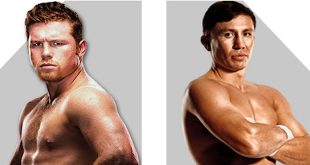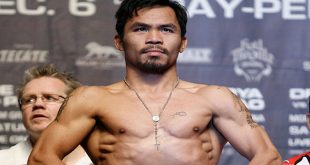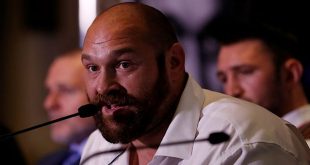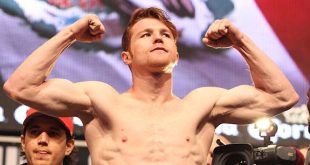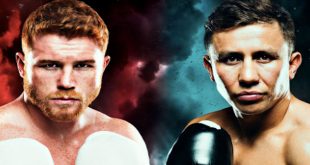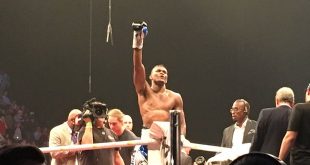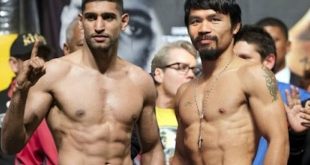As Amir Khan just crushingly found out, there is truth to the old boxing adage: ‘You can’t put muscles on chins’. It seems the ability to absorb a punch is something a boxer must be born with. Training can improve a fighter’s skills, power, fitness and ability to recover when hurt; but no amount of work can prepare a fighter to take a big shot on the chin. It seems some are just lucky to have a cast iron jaw while others are not.
Of course, over the years, many of the great champions have had excellent chins: Muhammad Ali, Jake La Motta, Marvin Hagler and Julio Cesar Chavez to name just a few. But there have also been many not nearly so blessed in this department. In this article, we look at some of the more noteworthy members of this group. We’re not saying these great fighters were chinny, just that they didn’t have world-class chins.
And perhaps we should admire the achievements of these more vulnerable champions even more so than those of their sturdier counterparts; to become a great champion without the safety net of a solid chin is truly remarkable. It is testament to these boxers’ skills and heart that they achieved greatness despite walking a tightrope of being only one punch away from sudden defeat.
Floyd Patterson – 55 wins 8 losses and 1 draw
The 1952 Olympic middleweight champion turned professional as a light heavyweight before quickly setting his targets on the heavyweight crown. He won it in 1956 by stopping Archie Moore in five rounds to become the then youngest heavyweight champion at 21 years and 10 months. Very quick for a heavyweight, Patterson was a sharp punching boxer with a fair amount of venom in his fists. His exaggerated ‘peek-a-boo’ defence made him difficult to hit cleanly, but perhaps also highlighted his concern for his punch resistance.
After four defences, Patterson’s jaw received a thorough examination in the form of the ‘Hammer of Thor’ right hand of Ingemar Johansson. He was put to the canvas seven times before being knocked out in the third. Patterson rebounded by sparking Johansson in the rematch, but again showed vulnerability in their third fight, going down twice before eventually winning by stoppage.
Patterson’s days as champion were brutally terminated by the hard-punching Sonny Liston, who stopped him in one round and then repeated the demolition trick in the rematch. Later in his career, he was stopped twice – in the 12th round and 7th round – by Muhammad Ali.
Small by today’s standards, it was Patterson’s skills and speed that brought him the heavyweight title, but his chin was his undoing against big punchers like Johansson, or bigger men like Liston and Ali.
Thomas Hearns – 61 wins, 5 losses, 1 draw
A legend of the ring with world titles at six different weights, Hearns was an exceptionally skilled fighter with one of the most devastating right hands in boxing history. Unusually tall and rangy, he carried his wrecking power up with him as he claimed world titles from the welterweight through to the cruiserweight division.
At welterweight, he destroyed everyone in his path on route to the WBA title. But his vulnerability surfaced in his big unification battle with Sugar Ray Leonard. The Kronk fighter was ahead on points but put down twice in the 13th round, before finally being stopped in the 14th.
A successful move up to light-middleweight saw him take the WBC crown from Wilfred Benitez and sensationally blast out Roberto Duran in two, but it was his middleweight war with Marvin Hagler that brutally highlighted the difference a chin makes. The granite-jawed Hagler survived the early shellacking from Hearns, but The Hitman could not withstand the return Hagler salvos and was knocked out in the third.
The Hearns chin was again found wanting as he was shockingly stopped by crude but strong Iran Barkley in a fight he was on the verge of winning. Finally, up at cruiserweight, he was kayoed in two by Uriah Grant in a defence of his IBO title. While it might seem harsh to say a welterweight who ended up trading blows with cruiserweights had a weak chin, Hearns was hurt on enough occasions to show he wasn’t the most resilient under fire.
Nigel Benn – 42 wins, 5 losses, 1 draw
One of Britain’s best champions, Nigel Benn blasted his way to 22 early consecutive stoppage wins after turning professional in 1987. In blitzing his opponents, Benn’s resilience wasn’t really questioned until he was floored by Anthony Logan in a fight he would win by third round knockout. Then came his dramatic Commonwealth title defence against Michael Watson. The challenger covered up, avoiding Benn’s big missiles, to take the Dark Destroyer into the uncharted waters of the middle rounds. Exhausted, Benn was stopped in the sixth.
He was on the floor again in winning the WBO middleweight title against Doug DeWitt, getting up to batter his teak tough opponent into defeat. In his first defence, Benn literally mugged the menacing Iran Barkley, stopping him on the three knockdown rule, but not before being severely shaken himself in a truly wild one round war.
These fights underlined that when Benn was hurt, he was dangerous. He lost his title to Chris Eubank after a back-and-forth war in which Eubank absorbed some huge shots before stopping Benn in the ninth. Up at super-middleweight, Benn was stunned in the final round of his rematch with the light-hitting Mauro Galvano, when successfully defending his WBC title.
Then, of course, came Benn’s greatest night against the seemingly unstoppable Gerald McClellan. Down in the first and eighth rounds, he roared back to stop the American – with well-documented tragic consequences. That fight summed up Benn as a fighter: vulnerable yet viciously dangerous, and with an indomitable will to win.
Michael Moorer – 49 wins, 4 losses, 1 draw
An aggressive box-puncher, Moorer blasted through the light heavyweight division with a string of 26 knockout victories, claiming the WBO title on the way. He probably could have reigned as light heavyweight king for years, but decided to mix it with the big men and jumped straight to the heavyweight division without even stopping at the cruisers. It was in this division that the cracks in the Moorer chin armoury began to show, even though he climbed to the very top of the division.
He was hurt by Alex Stewart and floored by Big Foot Everett Martin on his way to setting up a vacant WBO title bout with Bert Cooper. In a brutal slugfest, he and Smokin’ Bert bounced each other off the canvas before Moorer won by stoppage in the fifth. He was dropped again, but recovered to outbox and outpoint WBA/ IBF champ, Evander Holyfield. Then, in his very next fight, Moorer famously lost his belts when, ahead on points, he got pole-axed by a single right cross from the thunderous hands of George Foreman.
With his skills beginning to slip, Moorer’s chin increasingly got tagged and, more crucially, let him down. He was dropped five times in the Holyfield rematch, losing by eighth round stoppage. In a comeback, he was flattened by David Tua in just thirty seconds.
Whilst Moorer’s boxing skills and good power made him a formidable force up at heavyweight, he did display fragility up in this division. But perhaps it’s more accurate to say Moorer didn’t have a weak chin, he just had a light heavyweight’s chin in the heavyweight division.
Lennox Lewis – 41 wins, 2 losses, 1 draw
Britain’s greatest ever heavyweight, Lewis took Olympic gold in 1998 and turned professional, beginning a career that would see him win the heavyweight title on three occasions. At 6 foot 5, Lewis had great athletic ability, excellent boxing skills and knockout power. He won his first 22 fights with relative ease, culminating in his impressive two round stoppage of Razor Ruddock.
After being awarded the WBC belt out of the ring, Lewis was stunned in a successful defence against the big-hitting Frank Bruno. Finally though, his chin was exposed when he lost his title courtesy of a massive right-hand bomb from Oliver McCall. Lewis beat the count but was too dazed to continue and stopped.
After affirming his dominance in the division by taking all three major belts, he went into his defence against Hasim Rahman over-confident and under-prepared. Cracked on the jaw by a right hand from the 20-1 underdog, Lewis went down and out of the fight. Although Lewis would emphatically avenge these two stoppage defeats, the fact he didn’t recover from the two knockdowns put a big question mark over the quality of his chin. But there were times when Lewis was shaken but did prevail, such as in his battles with Shannon Briggs and Vitali Klitschko.
But Lewis’s boxing ability meant his chin was rarely tested; and his scalps included those of the monstrous-hitting David Tua and Mike Tyson. The last thing you want in the heavyweight division is a weak chin, Lewis didn’t have the strongest one, but he still will go down as one of its more distinguished champions.
Felix Trinidad – 42 wins, 2 losses
A devastating offensive fighting machine, Trinidad’s arsenal landed on its targets with laser-like accuracy and with chilling effect. He won the IBF welterweight title in 1993 by demolishing Maurice Blocker in two rounds, and defended this title 16 times, defeating the likes of Hector Camacho, Pernell Whitaker and Oscar De La Hoya.
Trinidad went down many times but virtually always got up to smash his opponent into defeat. This was perhaps best illustrated in his fight with the granite-chinned Yori Boy Campas. Down in the second and looking in trouble, Trinidad launched an all-out attack that left his opponent helpless against the ropes, ending the fight in the fourth round.
He also went down against world class fighters Oba Carr, David Reid and Fernando Vargas, but triumphed on each occasion. Trinidad’s undefeated march up through the divisions was halted in a middleweight unification bout with Bernard Hopkins. Here, the bigger Hopkins exposed Trinidad’s limitations, outboxing him and putting him down in the twelfth round, and, on this occasion, Tito would not get up and win.
In comebacks, Trinidad went down again before knocking out Ricardo Mayorga and most recently went to the canvas twice against Roy Jones Jr.
Throughout his career, many of Trinidad’s knockdowns appeared to do more with stance and balance than being truly hurt, but it is fair to say he didn’t have the most solid of chins. This, combined with his willingness to meet fire with fire, made for a hugely exciting career.
Roy Jones Jr. – 51 wins, 4 losses
Jones Jr was such a phenomenal athlete, with such incredible speed, power and reflexes, that we never knew what his chin was like, because no one was able to hit it. He dazzled his opponents with his speed and blasted them with his own vicious, fight-ending power shots. In the early part of his career, Jones looked untouchable, easily beating future Hall of Famers Bernard Hopkins, James Toney and Mike McCallum on route to world titles at middleweight, super middleweight, light heavyweight and even heavyweight.
The first sign that his chin didn’t match his other almost superhuman qualities was in his light heavyweight bout with Lou Del Valle. Dropped in the eighth by a hard straight left, Jones looked unsteady before regaining his composure to take a wide points win. But it was only after Jones made his stunning capture of the WBA heavyweight title from John Ruiz and then dropped back to light-heavyweight, that his vulnerability was fully revealed.
Jones’s style relied on his freakish speed and reflexes, and the weight changes appeared to have diminished them as he laboured to a points win over light heavyweight Antonio Tarver. Then, the unthinkable happened in the rematch: he was floored and stopped by a perfect left in the second. In his very next match, a right hand from Glen Johnson flattened Jones for three minutes.
These were shocking knockouts because Jones had never been hit on the chin like that before, and a fighter that looked unbeatable had been destroyed so emphatically. Jones was supremely gifted as a fighter, but the knowledge that his chin was fragile, makes his outstanding career up until winning the WBA heavyweight title look all the more exceptional.
 Boxing News Boxing News
Boxing News Boxing News
